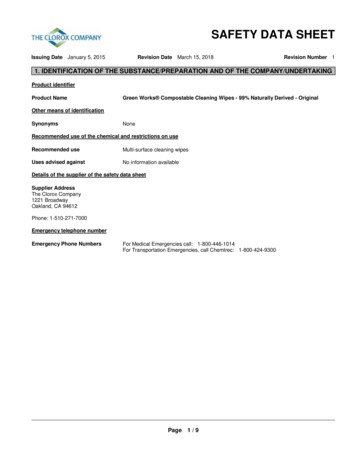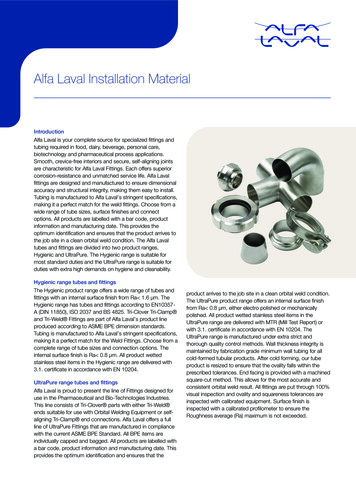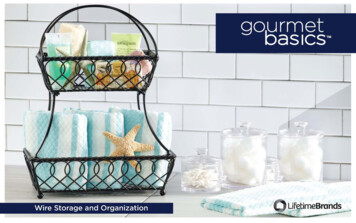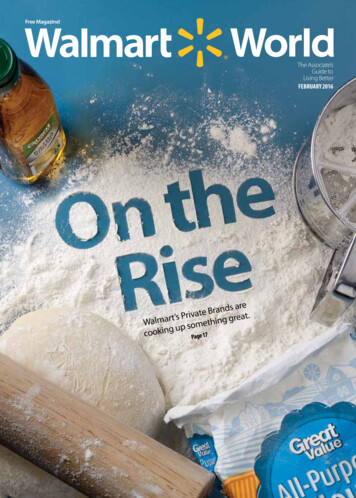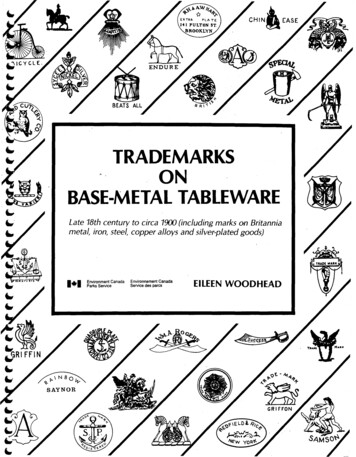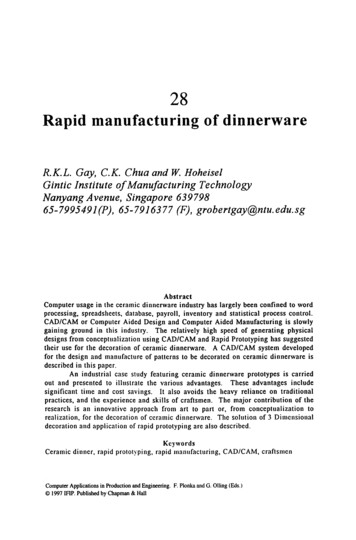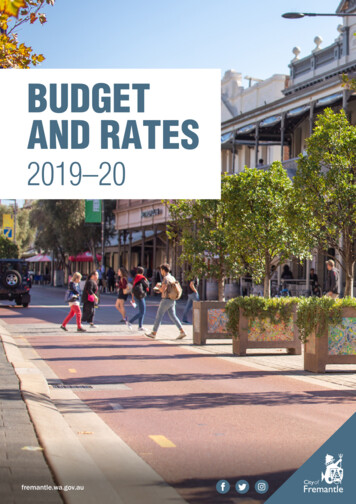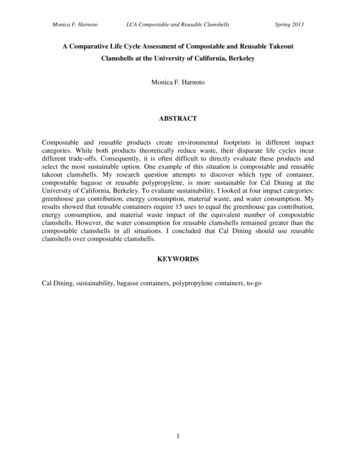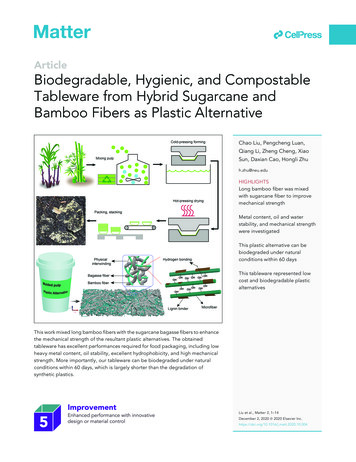
Transcription
llArticleBiodegradable, Hygienic, and CompostableTableware from Hybrid Sugarcane andBamboo Fibers as Plastic AlternativeChao Liu, Pengcheng Luan,Qiang Li, Zheng Cheng, XiaoSun, Daxian Cao, Hongli Zhuh.zhu@neu.eduHIGHLIGHTSLong bamboo fiber was mixedwith sugarcane fiber to improvemechanical strengthMetal content, oil and waterstability, and mechanical strengthwere investigatedThis plastic alternative can bebiodegraded under naturalconditions within 60 daysThis tableware represented lowcost and biodegradable plasticalternativesThis work mixed long bamboo fibers with the sugarcane bagasse fibers to enhancethe mechanical strength of the resultant plastic alternatives. The obtainedtableware has excellent performances required for food packaging, including lowheavy metal content, oil stability, excellent hydrophobicity, and high mechanicalstrength. More importantly, our tableware can be biodegraded under naturalconditions within 60 days, which is largely shorter than the degradation ofsynthetic plastics.Liu et al., Matter 3, 1–14December 2, 2020 ª 2020 Elsevier Inc.https://doi.org/10.1016/j.matt.2020.10.004
Please cite this article in press as: Liu et al., Biodegradable, Hygienic, and Compostable Tableware from Hybrid Sugarcane and Bamboo Fibersas Plastic Alternative, Matter (2020), eBiodegradable, Hygienic, and CompostableTableware from Hybrid Sugarcane and Bamboo Fibersas Plastic AlternativeChao Liu,1,2 Pengcheng Luan,1,2 Qiang Li,1,2 Zheng Cheng,1 Xiao Sun,1 Daxian Cao,1and Hongli Zhu1,3,*SUMMARYProgress and PotentialIn this study, we developed a pathway to valorize sugarcanebagasse left from sugar production to food-related end productsthrough pulp molding, which represents a sustainable materialand clean manufacturing. The sugarcane bagasse from the sugar industry is naturally safe for food-related applications. The producedtableware is fully biodegradable, renewable, and environmentallyfriendly. We also developed a hybrid fiber strategy that longbamboo fibers were blended with short sugarcane fibers, whichformed abundant physical interwinding in the obtained tablewarewith superior performances as required for food containers,including high tensile strength, superior oil stability, excellent hydrophobicity, and low heavy metal content. Of note, our tablewarewas mostly biodegraded under natural conditions within 60 days,which is largely shorter than the degradation time for synthetic plastics. Moreover, in comparison with polystyrene production, pulpmolding produced much less CO2 emission. The tableware madefrom biomass thus represents an eco-friendly, low cost, and biodegradable alternative to synthetic plastics for food packaging.Most synthetic plastics, includingpolystyrene, polyethylene, andpolyvinyl chloride, arenonbiodegradable, causingsevere environmental concerns.Replacing the plastics withbiodegradable, compostable,and environmentally friendlysubstitutes therefore representsan urgent need. However,applying traditional molded pulpto food packaging is still highlychallenging due to the high safetyand wet mechanical strengthstandard in the food industry. Thiswork addressed these challengesby mixing the long bamboo fiberwith sugarcane bagasse left fromthe sugar industry to enhance themechanical strength and preparesafe tableware. The producedtableware is biodegradable, foodpackaging safe, andcompostable, providing anexcellent alternative to currentsynthetic plastics.INTRODUCTIONPlastic made from fossil fuels has brought great convenience to our lives by way of itsscalable manufacturing process, light weight, robust mechanical properties, versatility, low cost, and resistance to corrosion.1 Plastic products have been widelyused in various fields, such as packaging, food industry, electronics, construction,and many other industries;2 among which about 16 billion disposable coffee cupsare consumed every year and half a billion plastic straws are discarded every dayworldwide.3 However, it takes as long as 450 years or even longer for some plasticsto degrade, especially single-use plastics such as plastic bags, lunchboxes, anddisposable cups, accounting for 40% of the total plastic production and renderingsevere ‘‘white pollution.’’4 Meanwhile, every year about 8 million tons of plasticwaste is dumped into oceans,5 which has caused significant harm to marine life. Current ‘‘white pollution’’ treatment includes landfilling, incineration, and recycling,6,7among which landfill treatment is the primary approach to handling single-use plastics; however, it is difficult for plastics to degrade naturally, which causes water pollution and restricted agriculture development. For plastic incineration, toxic substances produced such as fluorine, chlorine, and carbides can deplete the ozonelayer and harm human health.7,8 Waste plastic recycling is the best solution so farto reduce the ‘‘white pollution’’ but complex and high-cost treatments are generallyinvolved, which has significantly hindered its development.7,9 In fact, about 14% ofMatter 3, 1–14, December 2, 2020 ª 2020 Elsevier Inc.1
Please cite this article in press as: Liu et al., Biodegradable, Hygienic, and Compostable Tableware from Hybrid Sugarcane and Bamboo Fibersas Plastic Alternative, Matter (2020), ethe 78 million tons of plastic packaging produced last year were recycled and only2% of the recycled plastics have been recycled into the same or similar-quality applications.10 Therefore, developing environmentally friendly and biodegradable alternatives to current plastics represents an emerging need for a sustainable future.Tremendous efforts have been made to develop biodegradable materials to substitute conventional petroleum-derived plastics. Among the advancements, moldedpulp products made from wood fibers and recycled papers have been sought after.11,12 Such molded pulp products are inherently biodegradable and have beenused in packaging.13 Nevertheless, applying current molded pulp into food packaging is still highly challenging, mainly because of concerns regarding the safetyof food packaging and wet strength. First, most of the current molded pulps aremade from secondary fiber such as newspapers and used books. Such secondary fiber generally contains residual inks and other chemicals due to incomplete deinkingduring the pulping process, which is undoubtedly a concern for safety of food packaging. Meanwhile, the application of current molded pulp is hindered by its poorperformances with regard to low mechanical strength (11.25 MPa) and weak mechanical strength under oil and water.13,14 These poor performances could be attributed to the low quality of the fiber used for making molded pulp products. Forexample, the fibers from recycled paper are usually stiff and short, making it difficultto improve their external fibrillation by beating and drying. Developing molded pulpproducts that are safe for food packaging and have stable mechanical strength byusing sustainable resources could thus open a significant pathway for replacingtraditional food packaging.To produce a renewable and biodegradable alternative to the plastic-based foodcontainer that is inherently food-safe and mechanically strong, we have developeda clean, green, and sustainable production of tableware from the sugarcane bagasseleft over from the sugar industry as the feedstock. Sugarcane represents one of thelargest sugar sources worldwide. In 2017, the global production of sucrose from sugarcane amounted to 185 million tons, representing a 14.6 billion ton sugarcane market.15 However, the sucrose production also generates abundant bagasse as an industrial waste stream. For example, Brazil, the world’s largest sucrose producer,annually generates about 171 million tons of bagasse. Upgrading this large quantityof bagasse waste is thus one of the major challenging issues in the sugar industry.Bagasse is usually utilized for steam and power production for domestic sugar millsthrough incineration, landfill gas collection from landfilling, and biogas productionthrough anaerobic decomposition, and a small portion of bagasse is used as pulpfor paper manufacturing.16 However, the resultant sugarcane bagasse pulp oftenencounters low strength induced by its short fibers, which has significantly hinderedthe use of sugarcane bagasse pulp.17To address this challenge in sugarcane bagasse utilization, we have developed a fiberhybridization strategy by blending long bamboo fibers with the short sugarcane bagassefibers. The long bamboo fibers possess the advantages of long fibers, high mechanicalstrength, antivirus properties, and cost-effectiveness, and the short sugarcane bagassefibers can physically interwind with the long bamboo fibers to form a tightly interactednetwork that further enhances the mechanical properties of the derived end products.Moreover, in comparison with most trees, the growth period of bamboo is much shorterand its processability is generally better. Tremendous efforts have made in developingbamboo composites in various advanced fields such as membranes,18 aerogels,19 biofilms,20 and catalysts.21 All these inherent features make bamboo fiber a potential alternative to wood fiber to strengthen sugarcane bagasse pulp.2Matter 3, 1–14, December 2, 20201Departmentof Mechanical and IndustrialEngineering, Northeastern University, Boston,MA 02115, USA2These3Leadauthors contributed equallyContact*Correspondence: 0.004
Please cite this article in press as: Liu et al., Biodegradable, Hygienic, and Compostable Tableware from Hybrid Sugarcane and Bamboo Fibersas Plastic Alternative, Matter (2020), lFigure 1. Traditional Plastics and Conceptual Design of Pulp Molding for Plastic Alternatives(A and B) Schematic illustration of plastic manufacturing from petroleum refining (A) and moldedpulp using sugarcane bagasse and bamboo fibers to produce biodegradable tableware as analternative to plastics used in food industry (B).In this work, we aimed to develop quality molded pulp with food safety, superior mechanical strength, and water and oil stability as environmentally friendly, fully biodegradable, recyclable, and compostable tableware to replace the traditional plasticsused for food packaging. Sugarcane bagasse waste left over from the sugar industryas a renewable and food-safe feedstock were first used to prepare the pulp. The longbamboo fibers were subsequently added to enhance the mechanical strength of thesugarcane bagasse pulp. In addition, to improve the oil and water resistance ofmolded pulp products, a cost-effective and eco-friendly chemical, alkyl ketenedimer (AKD), was used to modify cellulose microfibers.The obtained molded pulp tableware had exceptional performances, including fullbiodegradability, excellent water and oil resistance, superior mechanical strength,low carbon emission, high food safety, and low cost, as well as excellent processability and scalability, which thus represents a potential replacement of current plastictableware for food packaging.RESULTS AND DISCUSSIONPetroleum refining has established vast platforms to produce plastic products(Figure 1A), which has become an essential part of our daily life. Along with the convenience plastics have brought us, the increased plastic production causes severeenvironmental pollutions. A large amount of plastic waste has flowed into the oceanfrom land and accumulated in the food chain, which is undoubtedly a threat to bothterrestrial and marine life (Figure 1A). In this work, we used renewable and biodegradable natural fibers from lignocellulosic biomass as feedstock for producingpulps to manufacture green tableware as an alternative to plastic for food packaging(Figure 1B). We have developed a fiber hybridization strategy to blend the longbamboo fibers with the short sugarcane bagasse fibers, which form a highly interwound composite that bamboo fibers embed in the sugarcane bagasse fiber matrixMatter 3, 1–14, December 2, 20203
Please cite this article in press as: Liu et al., Biodegradable, Hygienic, and Compostable Tableware from Hybrid Sugarcane and Bamboo Fibersas Plastic Alternative, Matter (2020), https://doi.org/10.1016/j.matt.2020.10.004lland serve as the reinforcer. The manufacturing process mainly included mixing sugarcane bagasse fibers with bamboo fibers, cold-press formation, hot-press drying,and packing (Figure 1B). With the same raw materials and the developed process,different mold shapes and various containers can be manufactured, such as a cup,box, and plate. This manufacturing approach has utilized the waste of the sugar industry to make tableware, which is clean, hygienic, and fits the requirements of foodrelated products. The process represents a green and sustainable conversion of theraw materials from Nature into food containers with superior biodegradability(Figure 1B).First, the morphology of the mixed fibers and the degradation properties of themolded pulp were investigated. As shown in Figures 2A and 2B, two different typesof fibers can be well defined in the pulp. The relatively wider and shorter fibers werederived from sugarcane bagasse pulp and the finer and elongated fibers werederived from bamboo pulp. Furthermore, as shown in Table S1, the analyses of fiberdistribution showed that the percentage of long fibers (3.0–4.5mm) in bamboo pulp(3.1%) is significantly higher than that in bagasse pulp (0.6%), but the average fiberwidth (18.6 mm) of bamboo fiber is considerably smaller than that of bagasse fiber(24.1mm). These mixed fibers can not only be more cost-effective than using onlybamboo pulp or wood pulp but also ensure the mechanical properties of thecomposite.Figures 2C–2F show the scanning electron microscopy (SEM) images of both surfaceand cross-section of a molded pulp cup. The fibers were bonded together by an adhesive substance that improved binding compactness between fibers (Figure 2C).This adhesive was mainly caused by the phase transition of the residual lignin inthe pulp during hot pressing and the increased hydrogen bonding betweencellulose inside the pulp during compression. Meanwhile, lignin is a hydrophobicpolymer and provides mechanical stiffness to the lignocellusic biomass; the residuallignin thus contributes to the water resistance and stiffness of the resultant tableware. In addition, SEM further confirmed that these fibers are composed of wide fibers and elongated fibers (Figures 2D and 2E). Because the sugarcane bagasse pulpas aforementioned contains many short fibers, this hybrid pulp can improve the mechanical properties of molded pulp products. From the cross-section of the moldedpulp tableware (Figure 2F), the entangled three-dimensional (3D) network of pulp fibers permeates small cavities between neighboring fibers, making the molding materials possess both high mechanical strength and light weight.Plastics made from petroleum refinery degrade with extreme difficulty in the naturalenvironment. In addition, petroleum resources are non-renewable and its continuous use will lead to its eventual depletion. Meanwhile, petroleum-based materialspossess severe environmental challenges. Even though some biodegradable polymers such as polylactic acid (PLA) have practical developments, their degradationnormally requires a specifically high temperature and takes a long time.22 Costeffective and sustainable production of highly biodegradable molded pulp materials thus has great potential to serve as the next generation of plastic substitutes.Unlike plastic, some lignocellulosic biomasses are common nutrients for many microorganisms, insects, and animals, such as bacteria, locusts, cattle, and sheep.The resulting biodegradation products of the pulp fibers are non-toxic and environmentally benign. To evaluate the biodegradability of molded pulp tableware, weburied them in natural soil and checked the changes in their morphologies andweights. As shown in Figures 2G and S1, after burying for 20 days, yellow fungiwere found on the surface of molded pulp tableware. After 30–45 days of interment,4Matter 3, 1–14, December 2, 2020Article
Please cite this article in press as: Liu et al., Biodegradable, Hygienic, and Compostable Tableware from Hybrid Sugarcane and Bamboo Fibersas Plastic Alternative, Matter (2020), lFigure 2. Characterization of the Morphology and Biodegradability of the Molded Pulp Tableware(A and B) optical microscopic images of mixed fibers (bagasse and bamboo fiber) at different magnifications.(C–E) SEM images of surface morphologies of molded pulp cups at different magnifications.(F–H) SEM image of the cross-section of the fibers in molded pulp cups (F). Photo images of molded pulp tableware displayed high biodegradationproperties (G) of molded cup as compared with that of a plastic lunchbox (H).the tableware started to deform. After 60 days, pristine molded pulp totally lost itsshape and gradually disappeared. Meanwhile, the dry weight of molded pulp cupbefore and after 60 days of interment was 7.99 g and 4.18 g, respectively (Figure S2),suggesting that almost half of the molded cup was degraded. In contrast, afterwashing the surface of the polystyrene (PS) plastic tableware, there was no significant change in its shape and surface after being buried for 60 days (Figure 2H). Theseresults proved that the molded pulp had much better biodegradability than the conventional PS plastic.Matter 3, 1–14, December 2, 20205
Please cite this article in press as: Liu et al., Biodegradable, Hygienic, and Compostable Tableware from Hybrid Sugarcane and Bamboo Fibersas Plastic Alternative, Matter (2020), https://doi.org/10.1016/j.matt.2020.10.004llFigure 3. Heavy Metals Content and Water and Oil Resistances of Molded Pulp Tableware(A) The contents of heavy metals (Pb and As) as compared with that required by Food ContactMaterials Regulation (EC) No. 1935/2004.(B and C) Images of our molded pulp tableware showed oil (B) and hot oil (C) resistance.(D and E) Contact angle (D) and water absorption (E) of our molded pulp. Both oil and waterresistances were measured using the SFMP, commercial bagasse tableware, and filter paper ascontrols.We thereafter evaluated the performances of the molded pulp as food tableware.First, food safety is the principal demand for food containers. Heavy metals existingin food containers can be harmful to human health and have been regulated underthe European Food Contact Materials Regulation (EC) No. 1935/2004 and the ChinaNational Food Safety Standard—Food Contact Paper and Board Materials and TheirProducts (English Version) GB 4806.8–2016,23,24 which state that contents of heavymetals Pb and As should be below 3.0 mg/kg and 1.0 mg/kg, respectively. As characterized by an inductively coupled plasma optical emission spectrometry (ICPOES), our molded pulp tableware had a Pb content of 0.3633 mg/kg while no Aswas detected (Figure 3A). These data demonstrated the safety of our moldedpulp as a food container.Second, oil and water resistances are the other two critical requirements for foodtableware, both of which ensure the physicochemical and mechanical propertiesof food tableware to protect the food quality and safety. To improve the waterand oil resistances of molded pulp, we added AKD to the pulp to efficiently changethe wettability of cellulosic fibers from hydrophilicity to hydrophobicity (see Experimental Procedures). For the oil resistance, grease resistance as defined by the standard of the Technical Association of the Pulp and Paper Industry (TAPPI) 559 pm-96represents the resistance to oil at room temperature (Table S2), which is numberedfrom 1 (the least aggressive) to 12 (the most aggressive).25 Likewise, hot-temperature oil resistance is used to measure the capacity of the tableware against the penetration of oil with a temperature higher than 180 F G 5 F (82 C G 3 C) (for details oftesting information, see Experimental Procedures). For the resistances to oil at roomtemperature and hot temperatures, a commercial bagasse tableware (plate), a6Matter 3, 1–14, December 2, 2020Article
Please cite this article in press as: Liu et al., Biodegradable, Hygienic, and Compostable Tableware from Hybrid Sugarcane and Bamboo Fibersas Plastic Alternative, Matter (2020), lcommercial egg tray made from secondary fiber molded pulp (SFMP), and filter paper were used as control samples. As depicted in Figures 3B and S3, the grease resistance of our molded pulp was at level 6, which was much higher than that of theSFMP (level 1), the commercial bagasse tableware (level 4), and the filter paper (level1), highlighting its excellent resistance to oil at room temperature. Moreover, theresistance to oil at high temperature was measured within a 10-min scale after dropping hot soybean oil on the surface of the samples. As shown in Figures 3C and S4,the hot oil penetrated rapidly into the SFMP and filter paper once it was dropped onthem (0 min), whereas our molded pulp tableware showed good resistance to thehot oil as no significant penetration was observed. In addition, the dropped oilwas absorbed by a cotton ball after 10 min of penetration. Oil was found to penetrate into the SFMP, bagasse tableware, and filter paper, but no significant penetration was found for our molded pulp. We further increased the oil temperature to90 C (194 F) and the penetration time to 30 min. Our molded pulp tableware stilldisplayed no significant penetration after dropping the oil (Figure S5). All these results demonstrate the excellent resistance of our molded pulp against the oil at bothroom temperature and high temperature.To evaluate the water resistance of our molded pulp, we determined both the contact angle and relative water absorption. As shown in Figures 3D and S6, the SFMPand filter paper did not display a contact angle and the commercial bagasse tableware showed a contact angle of 93 , while our molded pulp had a contact angle of127 , revealing much higher hydrophobicity compared with the commercial bagassetableware and SFMP. Additionally, when both SFMP and our molded pulp wereplaced on the deionized water, the former sank to the bottom but the latter floatedon the surface (Figure 3D). This difference was due to SFMP being highly hydrophilicand therefore sank to the bottom after absorbing water, while the molded pulp possesses high hydrophobicity that impeded water absorption and thus floated on thesurface. Although our molded pulp tableware, commercial bagasse tableware,SFMP, and filter paper can all absorb water to a certain extent during the longterm immersion process as revealed by SEM characterization of their 3D networkstructures (Figure 2), our molded pulp (59.4%) had much lower relative water absorption than the commercial bagasse tableware (77.5%), filter paper (149.2%), andSFMP (310%) (Figure 3E), possibly induced by its high hydrophobicity and denserstructure (for details of testing information, see Experimental Procedures). All theseresults of the high hydrophobicity and low relative water absorption of our moldedpulp revealed its high water resistance. In fact, the cup made of molded pulp canhold hot water with a temperature of 90 C (194 F) for more than 30 min withoutany penetration (Figure S7), which further displayed its excellent resistance againsteven hot water. Our molded pulp tableware, therefore, has displayed its great potential to be applied to the food industry for items such as drinking cups for hotliquid, lunchboxes, and food trays, which could contribute significantly to plasticreplacement.The mechanism of the excellent water and oil resistance probably lies in the AKD weadded to the pulp. The reactive group (lactone group) of AKD can react with the primary hydroxyl group of cellulose through esterification to form b-carbonyl ester linkages (Figure S8). Meanwhile, the hydrophobic group (long-chain alkyl group) turnsto face away from the cellulose surface to endow cellulose with a liquid-repellentproperty. All these changes contributed to the significant improvement in waterand oil resistances of the pulp products. Moreover, AKD can be safely used as aningredient in food packaging,26 highlighting the environmentally friendly andfood-safe properties of the molded pulp tableware.Matter 3, 1–14, December 2, 20207
Please cite this article in press as: Liu et al., Biodegradable, Hygienic, and Compostable Tableware from Hybrid Sugarcane and Bamboo Fibersas Plastic Alternative, Matter (2020), eFigure 4. Mechanical Properties of Dry and Wet Molded Pulp(A and B) Tensile strength (A) and Young’s modulus (B) of molded pulp cup and PS plastic cup.(C) Photographic images of molded pulp cup with and without load.(D) Load-bearing tests of molded pulp cup showed high stiffness.(E) Schematic illustration of the mechanism of the good mechanical properties of our molded pulp with the hybrid fibers.(F) Photographic images of our molded pulp cup soaking in colored water showed good water stability after 8 h of immersion.(G) Wet mechanical strength of our molded pulp cup, secondary fiber molded pulp, and commercial bagasse tableware. The water content of allsamples was controlled at 33.5%.The tensile strength, Young’s modulus, stiffness, and wet strength were the fourcrucial mechanical properties of the tableware, because molding materials withthese good mechanical properties can meet the requirements of high load-bearingcapacity and transportation safety in humid environments. As shown in Figures 4Aand 4B, our molded pulp cup had much higher tensile strength and Young’smodulus than the commercial PS plastic cup. The tensile strength of our moldedpulp cup was 35.0 MPa, which was about 2-fold higher than that of the PS plasticcup (15.6 MPa) (Figure 4A). Meanwhile, the Young’s modulus of our molded pulpcup was 3.25 GPa, much higher than that of the PS plastic cup (1.40 GPa) (Figure 4B).Moreover, there was a positive correlation between Young’s modulus and stiffness.A 7.9g molded pulp can withstand 3 kg of weight (380 times its own weight) in the8Matter 3, 1–14, December 2, 2020
Please cite this article in press as: Liu et al., Biodegradable, Hygienic, and Compostable Tableware from Hybrid Sugarcane and Bamboo Fibersas Plastic Alternative, Matter (2020), lvertical direction without obvious height change and deformation (Figure 4C), whilethe PS plastic cup collapses under this load (Figure S9). As shown in Figure 4D, theload ability of the molded pulp and PS cup was 1.07% and 4.37%, respectively. Bothresults demonstrated the excellent stiffness of our molded pulp tableware withpromising prospects for large-scale applications. In addition, the tensile strengthof our molded pulp was much higher than SFMP (1.1 MPa) and commercial bagassetableware (16.9 MPa) (Figure S10). These good mechanical properties of our moldedpulp were attributed to the physical interwinding between mixed fibers, the residuallignin in the pulp, and fiber surface modification (Figure 4E). First, the physical interwinding between bagasse short fibers and bamboo long fibers increased the mechanical strength of molded pulp products. In addition, during hot pressing inmolded pulp manufacture, as a natural binder, the remaining lignin can enhancethe binding between different components and the hydrogen bonds between microfibers. Meanwhile, phase transition of the remaining hydrophobic lignin mightcontribute to the water resistance and stiffness of molded pulp products. Lastly,the AKD hydrophobic treatment of the fiber surface made the samples less susceptible to the influence of the humid environment and thus enhanced the tensilestrength of our molded pulp products.Besides the mechanical performances discussed above, wet strength, i.e., thestrength of paper or paperboard in the wet state, is another important mechanicalperformance of the molded pulp cup. To measure the wet strength, we immersedthe molded pulp cup in water for 8 h. To visualize the change in the molded pulpcup, we added indigo carmine (blue) to the water. As shown in Figure 4F, themolded pulp cup maintained its good shape without collapse. After sucking theliquid on the surface of the paper cup using filter paper, the wetted part onboth sides of the paper cup was cut to measure its wet strength. As shown in Figure 4G, compared with wet commercial bagasse tableware (3.57 MPa) and wetSFMP (0.07 MPa), our wet molded pulp cup had a tensile strength of 7.50 MPa,demonstrating its excellent wet mechanical property. Since our molded pulp cupwas highly water resistant as revealed above, it was no surprise that the fiberscan prevent water swelling and thus keep the fiber network intact throughhydrogen bonding along the internal microfibers, which thus gave the moldedpulp tableware good wet strength.The possible environmental impacts of our molded pulp manufacturing were evaluated. It is well established that plastic originating from fossil fuel has a large carbonfootprint for the chemical conversion of oil or gas to plastic resin. This traditionalplastic production is also energy intensive with high CO2 emission. CO2 equivalentto the production of 1 kg of expanded PS plastic was reported as 7.36 kg27 while for1 kg of PLA it was 0.50 kg.28 In contrast, the manufacture of molded pulp productswas less energy wasteful with lower CO2 emission. According to the analysis andcalculation of the carbon footprint of carton board products developed by the Association of European Carton, Board and Carton Manufacturers (Pro-Carton),29 1 ton ofcardboard stores 1,474 kg of CO2, and fossil emissions require 964 kg of CO2 to produce 1 ton of con
box, and plate. This manufacturing approach has utilized the waste of the sugar fitstherequirementsoffood-related products. The process represents a green and sustainable conversion of the raw materials from Nature into food containers with superior biodegradability (Figure 1B).

